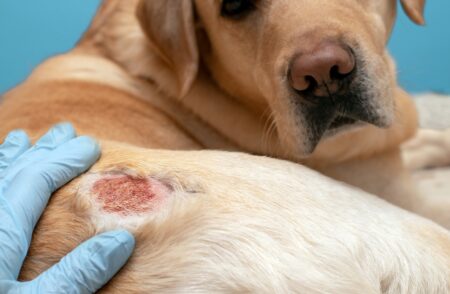Dog Hot Spot Healing Stages: A Guide For Pet Owners
No pet owner wants to see their beloved pup suffer from an itchy, uncomfortable hot spot. Hot spots are also known as acute (sudden) moist dermatitis and can quickly become a serious health issue for your pup if left untreated. Fortunately, there are steps you can take to help your pup heal and prevent future hot spots. This guide will provide a step-by-step process to help you take the necessary steps for addressing and managing your pup’s hot spot. It will cover all aspects of healing, including recognizing the symptoms, diagnosing the condition, creating and using an effective treatment plan, and preventing future hot spots. This will ensure that your pup is back to its healthy and happy self in no time.
Dog Hot Spot Healing Stages: A Guide For Pet Owners
A dog hot spot is a skin condition in which a lesion or area of irritated skin develops due to an environmental or health trigger, such as flea bites, yeast or bacterial infections, or allergies. Hot spots can heal through a series of stages, beginning with inflammation and progressing to the formation of new skin and fur.
Stage 1: Inflammation – At the beginning of the healing process, the hot spot becomes inflamed. It may look reddened and may have a raised bumpy appearance. The area of the skin may be itchy, painful, and swollen.
Stage 2: Formation of Pus – With continued irritation, the hot spot continues to worsen. A yellowish fluid that contains immune cells, bacteria, and other materials collects in the lesion due to increased inflammation.
Stage 3: Scabbing – The pus eventually dries up and forms a scab or crust over the hot spot. The scabs help protect the area and prevent further infection.
Stage 4: Scarring – As the hot spot slowly heals, the skin cells in the affected area start to regenerate. The newly formed skin cells may be thicker than the surrounding skin, leading to the formation of a scar.
Stage 5: Hair Growth – Finally, fur begins to regrow over the healed hot spot. This can take several weeks and the hair may grow in thinner or darker than the surrounding areas of fur. With proper care, the hot spot should eventually heal completely.
What Are Hot Spots On Dogs?
Hot spots on dogs are areas of intensely itchy, reddened, swollen, and often painful skin. The medical term for a hot spot is acute moist dermatitis. They are usually caused by underlying skin allergies, or by excessive licking or chewing at the spot due to irritation or boredom. Hot spots can also be caused by other skin infections, or a bite or sting from an insect. Treatment typically involves clipping the fur around the spot, cleaning the area with a medicated shampoo, and applying a topical antibiotic ointment. In severe cases, oral antibiotics may be needed.
What Does A Hot Spot Look Like On Dogs?
A hot spot on a dog is a moist, raw patch of skin that is usually red, inflamed, and slightly raised. It often appears as an open wound and can be warm to the touch. It can also emit a strong smell due to the bacteria that accumulate on the spot. Hot spots are most likely to develop on areas of the body where there is a lot of fur, such as the neck, belly, and legs.
What is The First Stage of A Hot Spot?
The first stage of a hot spot on a dog is when the skin becomes red, irritated, and inflamed. This is usually caused by scratching, licking, or biting the area, and the area may become swollen and warm to the touch. The skin abrasion causes blood vessels beneath the surface to dilate, creating a hot spot on the skin. In some cases, the skin may ooze or secrete a yellow-colored fluid. The hairs in the area may start to stand up, and the hot spot may become itchy and painful for the dog.
Where Do Dogs Get Hot Spots?
Hot spots, or acute moist dermatitis, are areas of skin that become inflamed, irritated, and infected. They primarily occur on the head, hips, and chest of dogs, though they can appear anywhere. Hot spots usually form when a dog continually chews, licks, or scratches an area of skin. This causes the skin to become irritated and creates an ideal environment for bacterial growth. Hot spots can also result from underlying allergies, hormone imbalances, illnesses, or pests (such as fleas). They can become worse in humid or wet conditions.
What Causes Dogs to Get Hot Spots?
Hot spots, also known as moist dermatitis, are small areas of inflamed skin most commonly found on the head, hip, chest, and shoulder areas of dogs. The lesions are typically circular, red, irritated skin accompanied by hair loss and an offensive odor.
Hot spots can be caused by several factors, including infection, allergies, fleas, poor grooming, and skin irritation. These lesions are often very itchy, and symptoms can progress quickly, leading to infection and discomfort for the dog. They can occur year-round but are most common during periods of very high heat and humidity. To prevent hot spots from occurring, owners should take their dogs for regular grooming sessions and check their skin for any signs of irritation.
SEE ALSO: What Is Dog Life Expectancy After Heartworm Treatment?
Dog Breeds Prone to Hot Spots
“Hot spots” is a common name for a skin infection called Pyotraumatic Dermatitis. It’s an infection caused by bacteria that can develop rapidly and cause inflammation in a dog’s skin. Some of the breeds most likely to develop this condition include · Labrador Retrievers · Golden Retrievers · Bichon Frise · German shepherds · Cocker Spaniels · Shih Tzu · Poodles · Bulldogs · Chihuahuas and Border Collies.
Symptoms of Hot Spot in Dogs
- Acute Moist dermatitis – Hot spots are characterized by red, irritated, inflamed patches of skin that ooze, weep clear fluid, and have a distinctive odor. The skin surrounding a hot spot is often swollen and painful. Common causes of hot spots are insect bites, allergies, excessive grooming, or anything else that causes skin irritation or inflammation.
- Loss of Hair – Hot spots often begin as small, round patches of hair loss, with the skin appearing pink and inflamed. Over time, the lesions can enlarge and spread to other areas of the body, resulting in large, raw patches on the skin.
- Itchiness – Hot spots are very itchy and it may be difficult for your dog to resist the urge to scratch or lick the area. This behavior may damage the skin further and provide an opening for secondary infection.
- Bad Odor – As the hot spot worsens, a strong, foul odor may develop as bacteria, mites, and/or fungi enter the wound and cause infection. This odor may indicate the presence of a more serious infection.
- Pain and Agitation – Hot spots are often very painful and will cause your dog to be uncomfortable and highly agitated. Your dog may be reluctant to move, eat, or be touched near the affected area.
How to Treat a Hot Spot on a Dog
- Clip the fur in the affected area: Begin by using small scissors or clippers to remove the hair from around the affected area. This can help you identify the exact spot and give you a better look at the affected skin.
- Clean the area: Clean the area by using mild soap and warm water. Make sure the hot spot area is fully cleaned and dried before continuing.
- Apply an antibiotic ointment: To help the area heal, apply a thin layer of antibiotic ointment to the area. This can help soothe the irritation as well as help protect the area from infection.
- Cover the area: Use a clean cloth or gauze to cover the hot spot and secure it with bandages or tape. This will help keep the area clean as it heals.
- Change the dressing daily: Change the dressing every day and clean the area as necessary. Continue to monitor the area to ensure the healing is progressing.
- Seek veterinary help if needed: If the hot spot does not seem to be getting better, seek veterinary help right away. The vet can prescribe a stronger antibiotic, if needed, or provide other treatments to help the area heal.
How to Treat Hot Spots On Dogs at Home
- Clip away the fur around the hot spot using sharp scissors. Be sure not to cut the skin.
- Clean the area with a dog-safe antiseptic, such as betadine or chlorhexidine.
- Apply a cooling agent, such as aloe vera gel, witch hazel, or a commercial hydrocortisone spray, to the affected area.
- Wrap the area in a sterile, non-stick gauze pad, being sure not to wrap too tightly.
- Change the bandage every four to six hours to keep the area clean and dry. Use a new antiseptic each time.
- Monitor your pet for signs of infection, such as redness or swelling of the area.
How to Prevent Hot Spots in Dogs
- Keep them groomed: Keeping your dog groomed is essential in both preventing hot spots and caring for any existing ones. Regular brushing will help remove excess fur and debris from your dog’s coat, which will help keep it cleaner and better aerated.
- Keep their coat short: Oftentimes, long or thick fur can make it harder for a dog’s skin to breathe and absorb oxygen. Consider giving your dog a trim before the hot season or clipping their fur close to the skin to allow their skin to better regulate its temperature.
- Use natural flea treatments: Fleas are notorious for causing hot spots, so it’s important to take steps to keep them away from your dog. Natural flea treatments such as apple cider vinegar, diatomaceous earth, and borax are all great options.
- Keep your dog cool: It goes without saying that it’s important to keep your dog away from extreme heat to help prevent hot spots. Make sure they have plenty of shade when outside, give them lots of rest and if possible, keep them in a cool area.
- Watch for warning signs: Checking your dog for possible hot spots regularly can help prevent them from worsening. If you notice any redness, sores, scabs, or bald spots, it’s best to check in with your vet right away.
FAQs
Q. How do I know if my dog’s hot spots are healing?
A. You should monitor your dog’s hot spots for signs of healing such as decreased redness or decreased pus production.
Q. How do you heal hotspots on dogs fast?
A. The quickest way to heal hotspots on dogs is to clean with a gentle antiseptic or diluted hydrogen peroxide, trim the fur around the area, dry the skin completely, and apply an anti-itch cream or ointment.
Q. How long does it take for hot spots to heal on dogs?
A. Hot spots typically heal within 7 to 10 days with the proper treatment.
Q. Can hot spots on dogs heal on their own?
A. In some cases, yes. Hot spots on dogs can heal on their own with proper management. This includes keeping the area clean, limiting the dog’s access to aggravating irritants, and providing frequent baths with an appropriate shampoo.
Q. Can hot spots kill a dog?
A. Yes, a hot spot can kill a dog if left untreated or if it becomes infected. If a hot spot is untreated, it could lead to serious health complications and even death.
SEE ALSO: Dog Eye Ulcer: Causes And Treatment
Conclusion
Overall, understanding the stages of dog hot spot healing can help you make sure your pet is on the right road to recovery. It’s important to remember that hot spots may not go away right away and that they can often be triggered by lifestyle factors like anxiety and boredom. As a pet owner, you should be alert for any signs of hot spot development and be prepared to take appropriate steps to provide your pet with relief and prevention.


